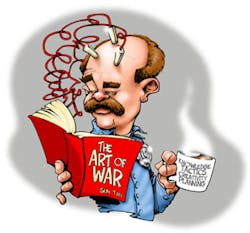Sun Tzu and the Art of Defensive Tactics
"The art if war is of vital importance to the state. It is a matter of life and death, a road either to safety or to ruin. Hence under no circumstances can it be neglected."
--Sun Tzu
The Art of War was written over 2,500 years ago by Chinese philosopher, Sun Tzu. While originally intended as a guide for military generals, the leadership attributes addressed in the book eventually drew the attention of many top business leaders. In fact, the book has become required reading at many American business schools. So what does an ancient Chinese book about military strategy, with overlapping application to the business world, have to do with you? Read on and see for yourself.
James Clavell, the author of the best-selling novel Shogun, edited a popular edition of The Art of War that consists of only 84 pages, encompassing 13 chapters. This column is comprised of five quotes, spanning four chapters, as well as accompanying text highlighting the relevance of The Art of War to modern police defensive tactics. Laying plans
"The general who wins a battle makes many calculations in his temple before the battle is fought. The general who loses the battle makes but few calculations beforehand."
This quote refers to the importance of doing your homework. You should have a plan for every conceivable contingency that could occur while performing your duties.
To illustrate this point, consider the following. When was the last time you practiced firearm retention? Would you be prepared to explain and demonstrate a firearm retention technique to your peers right now? An even more important question is this. Could you retain possession of your firearm if someone bigger and stronger than you was hell-bent on taking it from you? If your answer was anything other than an emphatic, "Yes!" you need to need to stop here and re-read the proceeding quote. No, really. Read it again.
Keep in mind that planning for this type of situation does not have to be an elaborate, formalized departmental training session. It can be as simple as speaking with one of your department's defensive tactics instructors for five minutes to refresh your memory and confirm that you completely understand this life-saving tactic.
The worst time to try to recall and execute a firearm retention technique is when someone is trying to take your firearm! The best time is now. So, go to your temple and make your calculations. Don't come out until you're confident in your ability to retain possession of your firearm under any circumstance. Make sense? Good. Let's move on. The sheathed sword"If you know the enemy and know yourself, you need not fear the result of a hundred battles. If you know yourself but not the enemy, for every victory gained you will also suffer a defeat. If you know neither the enemy nor yourself, you will succumb in every battle."
While, in most cases, you won't have the luxury of knowing specifically who your enemy will be, it is your duty to familiarize yourself with the tactics used by those who would prey on you or those you are sworn to protect. How can you do that? By reading relevant books, articles (particularly those from Officer.com), after action reports, watching dash cam footage, and studying statistics on officers killed and assaulted. Try to imagine yourself in the shoes of the officer in the scenario and think about you would have responded.
To know yourself means to recognize your limitations and vulnerabilities. Only after you've identified your weaknesses can you strive to improve them. That being said, if you're right-handed, you might never be as proficient at handcuffing with your left hand, regardless of how much you practice. Your goal should then be to manipulate the situation to accentuate your strengths and minimize your weaknesses. In this case, directing the suspect to a position that facilitates handcuffing with your right hand. Tactics"Security against defeat implies defensive tactics; ability to defeat the enemy means taking the offensive."
"Defensive tactics" is a term commonly used to describe any technique or tactic employed by an officer to effect an arrest, prevent escape, or overcome resistance. However, you will never accomplish any of these three tasks by being defensive.
Obviously blocking punches, escaping from holds, or preventing a suspect from acquiring your firearm are defensive responses. Although each of these is a critical skill, they will only delay your demise unless you manage seize the offense. Remember that the end result of every use of force incident should be the suspect modeling your "matching silver bracelets." There is nothing defensive about forcibly taking another person's freedom! Variation of tactics"In hemmed-in situations, you must resort to stratagem. In a desperate position, you must fight.
There is a time to talk and a time to act. Talking when acting was the appropriate response has lead to the deaths of far too many officers.
In most law enforcement encounters, there is adequate time to attempt to reason with whomever it is that you've contacted. With time on your side, you can consider the many options usually available to help resolve the situation. This is where tactical communication comes into play. If you can "sweet talk" the person you're dealing with into full compliance, life is good.
On the other hand, if the person you're dealing with suddenly points a firearm at you, talking should be the last thing on your mind. You are now in what Sun Tzu describes as a "desperate position" (slight understatement) and your only viable option is to fight, or in this case, shoot.
While I'm certain that I didn't do The Art of War justice, hopefully I've convinced you of it's relevance to modern policing. Pick up a copy and give it a read. I'm convinced that If every officer employed the tenets of this great work, lives would undoubtedly be saved.
Train hard. Stay safe!
